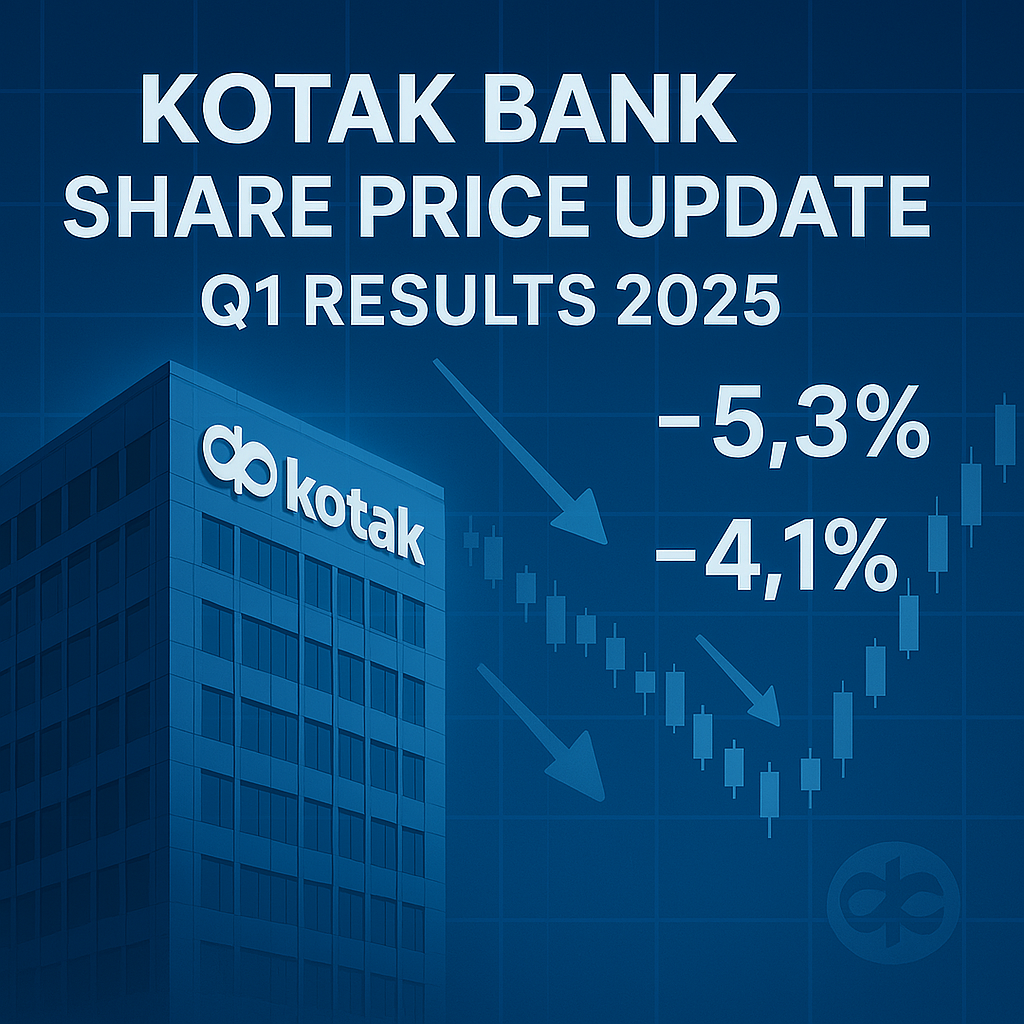
Kotak Bank Share Price 2025 Review: Why Shares Sank in Q1 & What Lies Ahead

Kotak Mahindra Bank’s share price fell over 6% post Q1 FY26 results due to a 7% YoY drop in net profit and elevated provisions. Here’s the full analysis on stock trends, broker views, and investor guidance.
Table of Contents
Published: July 28, 2025 | Last Updated: July 28, 2025
Kotak Mahindra Bank experienced significant share price volatility on July 28, 2025, with the stock declining by approximately 6.5% following the announcement of its first quarter results for fiscal year 2026. The shares traded in the range of ₹1,977 to ₹1,986 during the session, marking one of the steepest single-day declines for the private sector lender in recent months.
The price movement came after the bank reported its quarterly financial results, which showed mixed performance across various operational metrics. Kotak Mahindra Bank reported standalone net profit of ₹3,282 crore for Q1 FY26, representing a year-on-year decline from the previous year’s corresponding quarter. The results prompted varied reactions from market analysts and brokerage firms.
This analysis examines the bank’s quarterly performance, financial metrics, analyst perspectives, and broader implications for investors. All data is sourced from official stock exchange filings, regulatory disclosures, and verified financial documents.
Q1 FY26 Financial Performance Overview
Profit and Loss Statement Analysis
Kotak Mahindra Bank’s standalone net profit for the quarter ending June 2025 stood at ₹3,282 crore. This figure represents a 7% decline compared to ₹3,520 crore reported in the corresponding quarter of the previous fiscal year. The year-on-year comparison requires context, as the prior year included exceptional items that affected baseline comparisons.
The bank’s total income for Q1 FY26 reached ₹10,339 crore, reflecting a 6% increase from ₹9,756 crore in Q1 FY25. Net Interest Income (NII), a key measure of core banking profitability, stood at ₹7,259 crore for the quarter. This represented a 6% year-on-year growth from ₹6,847 crore in the corresponding period.
Operating profit for the quarter was reported at ₹5,564 crore, showing a 6% increase compared to ₹5,251 crore in Q1 FY25. However, provisions and contingencies surged significantly during the quarter, impacting bottom-line profitability. The bank set aside ₹1,208 crore for provisions, representing a substantial increase from the previous year’s levels.
Net Interest Margin Compression
One of the notable developments in Q1 FY26 was the compression in Net Interest Margin, which declined to 4.65% from 5.02% in the year-ago period. This represents a contraction of 37 basis points year-on-year. NIM measures the difference between interest income generated and interest paid out relative to earning assets, serving as a key indicator of banking sector profitability.
The margin compression reflects several factors affecting the banking industry. These include delayed transmission of monetary policy changes to lending rates, competitive pressure on deposit pricing, and shifts in asset composition. The time lag between changes in policy rates and their reflection in bank lending rates affects net interest margins across the sector.
According to industry analysis, deposit costs have increased due to competitive intensity among banks seeking to maintain or grow their deposit bases. This has put pressure on funding costs even as loan repricing adjusts gradually to changing interest rate environments. The balance between maintaining competitive deposit rates and preserving lending spreads remains a challenge for banks.
Asset Quality and Provisioning Analysis
Non-Performing Asset Trends
Kotak Mahindra Bank’s Gross Non-Performing Assets (GNPA) ratio stood at 1.48% as of June 30, 2025, compared to 1.39% in the corresponding period of the previous year. The modest increase in GNPA ratio indicates emerging stress in certain portfolio segments. GNPA represents loans where borrowers have defaulted on payments for a specified period as defined by Reserve Bank of India regulations.
The increase in NPAs was attributed to stress in specific lending segments. According to bank disclosures, microfinance portfolios experienced some pressure due to overleveraging concerns in certain rural markets. Additionally, retail commercial vehicle financing and certain unsecured personal loan categories showed signs of stress during the quarter.
Net NPA ratios, which account for provisions already set aside against bad loans, provide another perspective on asset quality. The bank maintained provision coverage ratios that offer cushion against potential loan losses. Provision coverage ratio measures the proportion of NPAs covered by provisions already made by the bank.
Provisioning Strategy
The bank’s provisioning and contingencies for Q1 FY26 reached ₹1,208 crore, marking a significant increase of over 100% compared to the year-ago period. This elevated provisioning reflects management’s approach to addressing emerging asset quality concerns proactively. Higher provisions reduce reported profit in the short term but strengthen the balance sheet’s ability to absorb potential losses.
Provisioning policies followed by banks are governed by RBI guidelines that specify minimum requirements based on asset classification. Banks can choose to maintain provisions above regulatory minimums as a prudential measure. Kotak’s increased provisioning suggests conservative risk management practices aimed at maintaining asset quality standards.
The impact of higher provisions on profitability is temporary, as provisions represent an allocation of earnings to cover potential losses rather than actual cash outflows in most cases. If asset quality improves and loans recover, excess provisions can be written back, positively impacting future profitability.
Capital Adequacy and Balance Sheet Strength
Regulatory Capital Metrics
Kotak Mahindra Bank maintained robust capital adequacy levels well above regulatory requirements. The bank’s Capital Adequacy Ratio (CAR) stood at 23.0% under Basel III norms, significantly exceeding the minimum regulatory requirement of 11.5% (including capital conservation buffer). CAR measures a bank’s capital relative to its risk-weighted assets, indicating its ability to absorb losses.
Tier 1 capital ratio, which measures core equity capital relative to risk-weighted assets, stood at 19.8%. Common Equity Tier 1 (CET1) ratio was reported at 18.5%. These metrics indicate strong capitalization providing cushion for business growth and potential stress scenarios. Higher capital ratios also provide flexibility for organic and inorganic growth opportunities.
The bank’s capital position exceeds not only regulatory minimums but also compares favorably with peer banks in the private sector. Strong capital ratios reduce the likelihood of requiring capital raises in the near term and provide confidence to depositors, creditors, and investors regarding the bank’s financial stability.
Liquidity Position
Liquidity metrics remained comfortable during the quarter. The Liquidity Coverage Ratio (LCR), which measures the bank’s ability to meet short-term obligations, stood at 142%. This exceeds the regulatory minimum of 100%, indicating adequate liquidity buffers. LCR requires banks to hold sufficient high-quality liquid assets to cover net cash outflows over a 30-day stress period.
Net Stable Funding Ratio (NSFR), measuring longer-term structural liquidity, was reported at 118%, also above the 100% regulatory minimum. NSFR ensures banks maintain stable funding profiles relative to their asset compositions and off-balance sheet activities. These ratios indicate the bank’s preparedness for various liquidity scenarios.
The Current Account Savings Account (CASA) ratio, an important metric for retail banks, stood at 40.9% compared to 43.4% in the year-ago period. CASA deposits represent low-cost funds for banks, as they typically bear lower interest rates compared to term deposits. The decline in CASA ratio suggests some shift toward higher-cost term deposits, contributing to funding cost pressures.
Business Growth Metrics
Loan Portfolio Expansion
Domestic advances grew by 14% year-on-year, indicating continued credit demand despite broader economic uncertainties. This growth rate reflects the bank’s ability to expand lending while maintaining underwriting standards. Loan growth in the banking sector depends on both credit demand from borrowers and banks’ willingness to lend based on risk assessments.
The composition of loan growth across segments affects overall portfolio risk and return characteristics. Corporate lending, retail loans, SME financing, and other categories each carry different risk-return profiles. Banks balance portfolio composition based on market opportunities, risk appetites, and strategic priorities.
Credit growth in the Indian banking system has shown resilience supported by economic recovery, government infrastructure spending, and consumer demand. However, growth rates vary across bank categories and depend on individual strategies regarding market segments and geographic focus.
Deposit Mobilization
Total deposits grew by 13% year-on-year, indicating the bank’s ability to attract funding despite competitive intensity in deposit markets. Deposit growth determines banks’ ability to expand lending operations, as deposits constitute the primary source of loanable funds for most banks. Maintaining deposit growth requires competitive interest rates, customer service quality, and distribution network strength.
The relationship between deposit growth and advances growth affects loan-to-deposit ratios, which indicate the proportion of deposits deployed as loans. Maintaining balanced growth ensures adequate liquidity while optimizing earning asset deployment. Banks manage these ratios based on liquidity requirements, regulatory guidelines, and strategic objectives.
Competition for deposits has intensified among banks and non-bank financial institutions. Small savings schemes offered by the government, mutual funds, and other investment products also compete for household savings. Banks adjust deposit rates based on their funding requirements and competitive positioning.
Market Reaction and Trading Activity
Share Price Movement
On July 28, 2025, Kotak Mahindra Bank’s shares opened lower following the earnings announcement and declined further during the trading session. The stock recorded an intraday high of approximately ₹2,120 before declining to an intraday low near ₹1,977. The closing price settled in the ₹1,986 range, representing a single-day decline of approximately 6.5%.
Trading volumes surged significantly compared to average daily volumes, indicating heightened investor activity in response to the quarterly results. Volume spikes typically accompany major corporate announcements as investors reassess positions based on new information. The increased volumes reflect active participation from both institutional and retail investor categories.
The stock’s decline made Kotak Mahindra Bank among the top losers on major indices for the day. The bank’s weight in key indices means its movement significantly influenced overall index performance. Banking sector indices experienced pressure due to Kotak’s decline, given the stock’s prominence in financial sector benchmarks.
Market Capitalization Impact
The share price decline resulted in market capitalization erosion of approximately ₹8,500 crore in a single trading session. Market capitalization equals share price multiplied by total outstanding shares, representing the company’s total equity value as perceived by markets. Single-day market cap changes of this magnitude reflect substantial investor reassessment of company valuations.
Market capitalization rankings among Indian banks are closely watched as indicators of relative market positioning. Kotak Mahindra Bank ranks among the top private sector banks by market capitalization, though the specific ranking varies with share price movements across the sector. Long-term market cap trends reflect business performance, growth prospects, and investor sentiment.
Valuation metrics such as price-to-book ratio and price-to-earnings ratio adjust with share price movements, affecting relative valuations compared to peer banks. Investors evaluate these metrics alongside business fundamentals to assess whether current valuations represent attractive entry points or suggest overvaluation concerns.
Analyst Perspectives and Target Prices
Research Firm Ratings
Multiple brokerage firms and research analysts issued reports following Kotak Mahindra Bank’s quarterly results. Analyst opinions varied, reflecting different interpretations of the results and outlooks on recovery timelines. Research coverage from both domestic and international firms provides diverse perspectives for investor consideration.
Emkay Global Financial Services maintained a cautious stance on the stock. According to their analysis, persistent margin pressure and rising credit costs presented challenges to near-term performance. The research firm maintained its existing rating on the stock with a target price of ₹1,950, suggesting limited upside from prevailing levels at the time of the report.
Nomura, an international brokerage firm, adopted a neutral position on Kotak Mahindra Bank shares. The firm revised its target price to ₹2,150, acknowledging the bank’s challenges while recognizing its fundamental strengths. The neutral rating indicated the firm saw balanced risk-reward with recovery expected but timing uncertain.
Optimistic Viewpoints
Jefferies, another prominent research firm, maintained a more positive outlook on Kotak Mahindra Bank despite the quarterly challenges. The firm retained its buy rating with a target price of ₹2,550, suggesting potential upside of approximately 28% from the post-results price levels. The firm’s analysis emphasized the bank’s franchise quality, digital capabilities, and long-term positioning.
The divergence in analyst opinions reflects genuine uncertainty about the bank’s near-term trajectory and recovery timeline. Some analysts focus more heavily on immediate challenges like margin compression and elevated provisions, while others emphasize longer-term competitive advantages and market positioning. Investors weigh these perspectives alongside their own analysis and investment horizons.
Target price ranges from different analysts—spanning from ₹1,950 to ₹2,550—indicate significant variation in valuation assessments. These differences stem from varying assumptions about margin recovery timing, asset quality trends, business growth rates, and appropriate valuation multiples for the bank’s earnings and book value.
Comparative Analysis with Peer Banks
Performance Benchmarking
Kotak Mahindra Bank’s performance metrics can be evaluated relative to other major private sector banks operating in India. HDFC Bank, ICICI Bank, and Axis Bank represent key competitors with similar business models and market positioning. Comparative analysis helps assess relative performance and competitive positioning.
Return on Equity (ROE), measuring profitability relative to shareholders’ equity, stood at approximately 11% for Kotak based on Q1 FY26 results. This compared with higher ROE levels reported by some peer banks including HDFC Bank at approximately 14% and ICICI Bank at around 13.5%. ROE comparisons require considering differences in business mix, risk profiles, and capital strategies.
Return on Assets (ROA), measuring profitability relative to total assets, provides another comparative metric. Kotak’s ROA of approximately 1.8% for the quarter fell below some peer banks but remained within reasonable ranges for the sector. ROA differences reflect variations in leverage, business models, and operational efficiency across institutions.
Asset Quality Comparison
Kotak’s GNPA ratio of 1.48% compared favorably with some peers while showing slight increases year-over-year. ICICI Bank reported GNPA ratios around 2.15%, while Axis Bank showed ratios near 1.62% according to their respective quarterly disclosures. HDFC Bank maintained GNPA ratios around 1.35%, among the lowest in the private sector.
Asset quality metrics depend significantly on portfolio composition, underwriting standards, economic conditions affecting different sectors, and management’s provisioning approaches. Banks with higher retail exposure may show different NPA patterns compared to those with significant corporate lending. Geographic concentration also influences asset quality based on regional economic conditions.
Provision coverage ratios, measuring provisions held against gross NPAs, vary across banks based on management conservatism and regulatory requirements. Higher coverage ratios provide greater cushion against potential losses but reduce reported profitability in the near term. These ratios reflect management philosophies regarding risk management and earnings volatility preferences.
Sector Trends and Macro Context
Banking Industry Dynamics
The Indian banking sector has experienced varied performance across institutions during FY26’s first quarter. According to RBI data, credit growth in the banking system has moderated from peak levels seen in the previous year but remains healthy by historical standards. Deposit growth has lagged credit growth in recent periods, creating loan-to-deposit ratio pressures across the system.
Net Interest Margins across the banking sector have faced pressure due to the lag between deposit repricing and loan repricing cycles. When policy rates change, banks adjust deposit rates relatively quickly due to competitive pressures, while loan rates adjust more gradually due to contractual terms and competition. This creates temporary margin compression during certain phases of interest rate cycles.
Asset quality trends vary across portfolio segments. Retail unsecured loans have shown some stress in certain banks’ portfolios, while corporate asset quality has generally remained stable. Microfinance portfolios have experienced challenges in some states due to overleveraging and repayment difficulties. Banks with different portfolio compositions show varying asset quality trajectories.
Monetary Policy Impact
The Reserve Bank of India’s monetary policy stance influences banking sector performance through multiple channels. Interest rate levels affect loan demand, deposit costs, bond portfolio valuations, and overall economic activity. During FY26, RBI maintained focus on balancing inflation management with growth support, keeping policy rates within established corridors.
Transmission of monetary policy changes to lending rates occurs with lags that vary across loan categories. Floating rate loans linked to external benchmarks like repo rate adjust relatively quickly, while loans linked to internal benchmarks or fixed-rate loans adjust more slowly. This transmission lag affects bank margins during policy tightening or easing cycles.
Liquidity conditions in the banking system influence banks’ funding costs and deposit rate decisions. RBI manages system liquidity through various instruments including repo operations, open market operations, and reserve requirements. Adequate system liquidity generally supports stable funding costs, while tight liquidity can pressure banks to raise deposit rates.
Digital Banking and Technology Initiatives
Digital Transformation Progress
Kotak Mahindra Bank has invested significantly in digital banking capabilities as part of its strategic priorities. The bank reported 28% year-on-year growth in digital transactions during Q1 FY26, indicating increasing customer adoption of digital channels. Digital transformation affects cost structures, customer experience, and competitive positioning in modern banking.
Digital customer acquisition reached 1.2 million new customers during the quarter according to bank disclosures. Digital onboarding processes have become increasingly important for banks seeking to expand their customer base efficiently. Mobile banking applications, internet banking platforms, and digital payment solutions form core components of banks’ customer acquisition and service delivery strategies.
Technology investments include core banking system upgrades, artificial intelligence implementations for customer service and risk management, data analytics capabilities, and cybersecurity enhancements. These investments require upfront capital expenditure but can generate long-term benefits through operational efficiency, improved customer experiences, and enhanced risk management capabilities.
Competitive Positioning
The competitive landscape for banking services has evolved with the entry of digital-first banks, fintech companies, and technology platforms offering financial services. Traditional banks face competition across various product categories including payments, lending, deposits, and wealth management. Maintaining competitive relevance requires continuous innovation and customer experience enhancement.
Kotak’s established customer franchise, regulatory banking license advantages, and trust factors provide competitive moats against newer entrants. However, maintaining market share requires matching or exceeding the customer experience and convenience offered by digital-native competitors. Partnerships with fintech companies represent one strategy banks employ to enhance their digital offerings.
Branch network strategies have evolved as digital adoption increases. While physical branches remain important for certain customer segments and complex transactions, banks are optimizing branch networks based on changing customer preferences. The balance between physical and digital distribution channels affects cost structures and customer accessibility.
Risk Factors and Challenges
Near-Term Headwinds
Several challenges face Kotak Mahindra Bank in the near term based on Q1 FY26 results and management commentary. Margin pressure from deposit repricing and competitive intensity requires active management through pricing strategies and product mix optimization. The timeline for margin recovery depends on policy transmission effectiveness and competitive dynamics evolution.
Elevated provisioning levels reduce profitability in the short term but reflect prudent risk management given asset quality signals in certain portfolios. If asset quality stabilizes or improves, provision requirements may normalize in subsequent quarters. However, economic conditions affecting borrowers’ repayment capabilities will influence actual credit costs experienced.
Competitive intensity across banking products affects both pricing power and market share dynamics. As banks compete for deposits, quality loans, and fee-based business, maintaining profitability while growing market share presents ongoing challenges. Strategic decisions regarding growth versus profitability trade-offs reflect management’s assessment of market opportunities and competitive positioning.
Regulatory Environment
Banks operate within extensive regulatory frameworks established by RBI, SEBI, and other authorities. Regulatory changes affecting capital requirements, lending norms, corporate governance, digital banking, and other areas require continuous adaptation. Compliance costs and operational adjustments associated with regulatory changes affect bank economics.
RBI’s approach to regulating digital banking, fintech partnerships, and emerging technologies will shape competitive dynamics. Clear regulatory frameworks facilitate innovation while maintaining financial stability and consumer protection. Banks monitor regulatory developments closely to ensure compliance and adapt business strategies accordingly.
Data privacy and cybersecurity regulations have gained importance with increasing digitalization. Banks invest in security infrastructure, data governance frameworks, and compliance systems to meet evolving regulatory expectations. Cyber incidents could affect customer trust and result in regulatory penalties, making cybersecurity a critical risk management priority.
Investment Considerations and Outlook
Valuation Metrics
Following the share price decline, Kotak Mahindra Bank’s valuation metrics adjusted to levels that some analysts consider attractive relative to historical ranges. Price-to-book ratio, a common valuation metric for banks, compressed due to the price decline. Historical comparisons show the current ratio relative to the bank’s trading ranges over different time periods.
Price-to-earnings ratios reflect market expectations for earnings growth and return levels. Lower P/E ratios may indicate market skepticism about near-term earnings trajectory or suggest value opportunities depending on investor perspectives. Comparing current multiples to historical averages and peer multiples provides context for valuation assessments.
Dividend yield, representing annual dividends relative to share price, increases when share prices decline assuming unchanged dividend policies. For income-focused investors, higher dividend yields may enhance investment attractiveness. However, dividend sustainability depends on ongoing profitability and regulatory capital requirements.
Recovery Timeline Expectations
Management commentary and analyst projections suggest potential recovery in key metrics during the second half of FY26. Margin recovery depends on completion of deposit repricing cycles and successful implementation of pricing strategies. As higher-cost deposits mature and reprice, NIM compression pressures may ease gradually.
Asset quality stabilization in stressed portfolios requires time as banks work through existing problem loans and adjust underwriting standards. If economic conditions remain stable or improve, fresh slippages may moderate, allowing provision requirements to normalize. Early indicators of asset quality trends will emerge in subsequent quarterly results.
Business momentum indicators including customer acquisition, digital transaction growth, and cross-selling success provide insights into long-term franchise strength beyond short-term profitability fluctuations. Sustaining or accelerating these momentum indicators supports optimistic scenarios regarding the bank’s competitive positioning and growth prospects.
Author Information
Author: Nueplanet
Designation: Banking Sector Analyst and Financial Markets Specialist
Nueplanet is a banking sector analyst with over the years of experience covering Indian financial services companies, regulatory developments, and capital markets. Nueplanet holds an MBA in Finance and has worked with leading financial research organizations analyzing bank performance and industry trends.
Expertise: Banking Sector Analysis, Financial Statement Analysis, Credit Risk Assessment, Regulatory Policy Impact
Commitment: All content is based exclusively on verified sources including regulatory filings with stock exchanges, RBI publications, company announcements, official financial statements, and government data. Analysis aims to provide factual information and objective perspectives to assist investor understanding. This content is for informational purposes only and does not constitute investment advice.
About This Publication
This financial news platform delivers evidence-based analysis of Indian equity markets, banking sector developments, and corporate performance. Our purpose is providing accurate, transparent information derived from official sources to support informed decision-making.
Information Sources:
- Stock exchange filings (NSE and BSE)
- Reserve Bank of India regulatory announcements
- Securities and Exchange Board of India disclosures
- Company quarterly results and investor presentations
- Banking sector regulatory guidelines
Editorial Principles:
- Factual accuracy verified against official documents
- Clear distinction between facts and analytical interpretation
- Regular content updates reflecting new information
- Independence from corporate interests
- Transparency regarding information sources
Reader Notice: Content serves educational purposes. We do not provide investment recommendations, stock purchase advice, or portfolio guidance. Readers should conduct independent research, review official company filings, and consult qualified financial advisors before making investment decisions.
Frequently Asked Questions
1. What caused Kotak Mahindra Bank’s share price decline on July 28, 2025?
The share price declined approximately 6.5% on July 28, 2025, following the announcement of Q1 FY26 financial results. The bank reported standalone net profit of ₹3,282 crore, representing a 7% year-on-year decline from ₹3,520 crore in Q1 FY25. Key concerns included Net Interest Margin compression to 4.65% from 5.02% year-ago, representing a 37 basis point decline, and significantly elevated provisions of ₹1,208 crore, more than doubling from prior year levels. The market reaction reflected investor concerns about margin pressure sustainability and asset quality trends in certain portfolio segments.
2. How does Kotak Mahindra Bank’s Q1 FY26 performance compare with major peer banks?
Kotak’s Q1 FY26 performance showed mixed results relative to peers. The bank’s Return on Equity of approximately 11% lagged HDFC Bank (around 14.2%) and ICICI Bank (approximately 13.5%) but remained within acceptable ranges for the sector. Asset quality metrics showed GNPA of 1.48%, which compared favorably with ICICI Bank’s 2.15% and Axis Bank’s 1.62%, though slightly higher than HDFC Bank’s 1.35%.
Net Interest Margin of 4.65% exceeded some peers but reflected compression from prior levels. Capital Adequacy Ratio of 23% remained among the highest in the sector, providing strong buffer for growth and stress absorption.
3. What are the analyst target prices and ratings for Kotak Mahindra Bank stock?
Analyst opinions varied following Q1 FY26 results. Emkay Global maintained a cautious stance with a target price of ₹1,950, citing concerns about persistent margin pressure and rising credit costs. Nomura adopted a neutral rating with a revised target of ₹2,150, acknowledging challenges while recognizing fundamental strengths.
Jefferies maintained a more optimistic view with a buy rating and ₹2,550 target price, emphasizing franchise quality and long-term positioning. The range of target prices from ₹1,950 to ₹2,550 reflects differing assumptions about recovery timelines, margin trajectories, and valuation methodologies. Investors should review detailed research reports and consider multiple perspectives alongside their own analysis.
4. What factors contributed to Net Interest Margin compression at Kotak Mahindra Bank?
The 37 basis point NIM compression to 4.65% from 5.02% year-on-year stemmed from several factors. Deposit repricing occurred faster than loan repricing due to competitive pressure for deposits across the banking system and contractual lags in adjusting lending rates. Rising deposit costs reflected competitive intensity as banks sought to maintain or grow deposit bases amid system-wide credit-deposit ratio pressures.
Changes in asset mix toward lower-yielding but potentially safer categories also affected overall margins. The lag between RBI monetary policy changes and their transmission to lending rates created temporary margin pressure. Industry observers expect gradual margin recovery as repricing cycles complete and policy transmission improves.
5. How significant is the increase in Kotak Mahindra Bank’s provisions and what does it indicate?
Provisions and contingencies of ₹1,208 crore in Q1 FY26 represented over 100% increase from year-ago levels. The elevated provisioning reflects emerging stress in specific portfolio segments including microfinance, retail commercial vehicles, and certain unsecured personal loan categories. Management’s decision to increase provisions proactively demonstrates conservative risk management and preparation for potential loan losses.
While higher provisions reduce short-term reported profitability, they strengthen the balance sheet’s ability to absorb losses and can be written back if asset quality improves. The provisioning approach indicates management priority on maintaining asset quality standards and provision coverage ratios rather than maximizing near-term earnings.
6. What is Kotak Mahindra Bank’s capital position and how does it support future growth?
Kotak Mahindra Bank maintained robust capital levels with Capital Adequacy Ratio of 23.0% under Basel III norms, significantly exceeding the regulatory minimum of 11.5%. Tier 1 capital ratio stood at 19.8% and Common Equity Tier 1 at 18.5%, both well above requirements. This strong capital position provides multiple benefits including cushion for business expansion without requiring immediate capital raises, ability to absorb potential losses during stress scenarios, flexibility for organic growth and potential acquisitions, and confidence to stakeholders regarding financial stability.
The capital strength positions Kotak favorably compared to many peers and supports management’s ability to pursue growth opportunities while maintaining regulatory compliance.
7. What are the key risks facing Kotak Mahindra Bank in the current environment?
Primary risks include sustained margin pressure if competitive intensity for deposits continues and policy transmission remains delayed, potential asset quality deterioration in stressed segments requiring continued elevated provisioning, economic slowdown impacts on credit demand and borrowers’ repayment capabilities, competitive threats from digital-first banks and fintech companies affecting market share and pricing power, and regulatory changes affecting business models or compliance costs.
Additional considerations include interest rate risk affecting bond portfolios and deposit franchise, operational risks associated with digital transformation and cybersecurity, and execution risks in implementing strategic initiatives. However, Kotak’s diversified business model, strong capital position, and established management team provide risk mitigation capabilities.
8. What is the outlook for margin recovery at Kotak Mahindra Bank?
Analysts and management commentary suggest potential margin recovery during the second half of FY26, though timing remains uncertain. Recovery depends on completion of deposit repricing cycles as higher-cost deposits mature and reprice to current market rates, improved transmission of RBI policy rates to lending rates across loan categories, successful implementation of pricing strategies and product mix optimization, and moderation of competitive intensity for deposits.
Potential margin improvement of 15-20 basis points from current levels appears feasible if these factors materialize. However, recovery timeline depends on competitive dynamics, regulatory factors, and economic conditions. Investors should monitor quarterly NIM trends and management commentary regarding margin trajectory and pricing strategies.
9. How does Kotak Mahindra Bank’s digital banking performance compare with peers?
Kotak reported 28% year-on-year growth in digital transactions during Q1 FY26, indicating strong digital adoption among customers. The bank added 1.2 million new customers during the quarter, with significant digital acquisition components. Investments in technology infrastructure, mobile banking applications, payment solutions, and AI-powered services position Kotak among leaders in digital banking capabilities.
However, all major private sector banks have made substantial digital investments, creating a competitive landscape. Digital leadership provides advantages in customer acquisition costs, operational efficiency, and customer experience, though maintaining leadership requires continuous innovation. The bank’s digital strategy includes partnerships with fintech companies and internal capability development to address evolving customer preferences.
10. What factors should investors consider when evaluating Kotak Mahindra Bank at current levels?
Investors should evaluate multiple factors including valuation metrics relative to historical ranges and peer comparisons, considering whether current levels reflect appropriate risk-reward balance, recovery timeline expectations for margins and asset quality, with assessment of management’s ability to execute improvement plans, business momentum indicators beyond short-term profitability including customer acquisition, digital growth, and market share trends,
capital strength providing cushion and growth flexibility, competitive positioning relative to both traditional banks and digital entrants, and personal investment horizon and risk tolerance alignment with the stock’s characteristics. Long-term investors may view current levels differently than short-term traders. Reviewing quarterly progress on key metrics and management commentary provides ongoing assessment framework. Consultation with financial advisors regarding portfolio fit remains advisable.
11. What is the significance of Kotak Mahindra Bank’s CASA ratio decline?
The Current Account Savings Account (CASA) ratio declined to 40.9% from 43.4% year-ago, indicating a shift in deposit mix toward higher-cost term deposits. CASA deposits typically bear lower interest rates compared to term deposits, making them preferred funding sources for banks. The ratio decline suggests increased competitive pressure requiring higher rates to attract deposits and potential customer preference for term deposits offering better returns in current interest rate environment.
Lower CASA ratios increase overall funding costs, contributing to margin pressure. However, Kotak’s CASA ratio remains relatively healthy compared to industry averages. Stabilizing or improving this ratio represents a priority for management, as it directly affects funding costs and profitability. Strategies include enhancing digital banking convenience, relationship-based pricing, and product innovations to attract low-cost deposits.
12. How might economic conditions affect Kotak Mahindra Bank’s performance in coming quarters?
Economic conditions influence banking performance through multiple channels. GDP growth rates affect credit demand as businesses and consumers adjust borrowing based on economic outlook and confidence levels. Employment trends and wage growth influence retail borrowers’ repayment capabilities and demand for consumer loans. Corporate sector health affects commercial lending opportunities and corporate borrowers’ debt servicing abilities.
Inflation levels influence RBI monetary policy decisions, which in turn affect interest rates, credit growth, and bank margins. Real estate and construction sector trends impact both lending opportunities and asset quality in these portfolios. According to various economic projections, India’s GDP growth is expected to remain in the 6-7% range, providing a supportive backdrop for banking sector performance, though specific bank performance depends on individual strategies and execution.
13. What is the timeline for Kotak Mahindra Bank’s full recovery to normalized profitability levels?
Recovery timelines remain subject to multiple variables and market uncertainties. Analyst expectations suggest potential improvement visibility during H2 FY26 (October 2025-March 2026) as margin compression stabilizes and provisioning normalizes. Key milestones include margin recovery beginning in Q3 FY26 as repricing effects materialize, credit cost normalization as asset quality stabilizes in stressed portfolios, fee income growth from digital initiatives and cross-selling activities, and demonstration of sustained business momentum through customer acquisition and market share metrics.
Full recovery to historical ROE and ROA levels may require additional quarters beyond FY26 depending on execution success and market conditions. Management guidance in subsequent quarterly results will provide updated perspectives on recovery trajectory. Investors should monitor actual performance against these expectations to assess progress.
14. How does Kotak Mahindra Bank’s provisioning compare with regulatory requirements?
RBI regulations specify minimum provisioning requirements based on asset classification and age of NPAs. Standard assets require minimal provisions (typically 0.25-0.40% depending on category), while NPAs require progressively higher provisions based on classification as substandard (15%), doubtful (25-100% depending on age), or loss (100%) assets. Kotak’s elevated provisions exceed minimum regulatory requirements, reflecting management’s conservative approach and preparation for potential deterioration.
This practice, while reducing short-term profits, strengthens provision coverage ratios measuring total provisions relative to gross NPAs. Higher coverage ratios provide greater cushion against actual losses if NPAs are ultimately written off. The approach reflects management philosophy prioritizing balance sheet strength and long-term stability over maximizing short-term reported earnings.
15. What role does Kotak Mahindra Bank’s diversified business model play in its performance?
Kotak Mahindra Bank operates a diversified financial services model spanning retail banking, corporate banking, commercial banking, treasury operations, and subsidiaries in insurance, securities, asset management, and other financial services. This diversification provides multiple revenue streams reducing dependence on any single business line. When one segment faces challenges, others may demonstrate strength, stabilizing overall performance.
The model enables cross-selling opportunities across group entities, enhancing customer lifetime value and relationships. Fee-based businesses including wealth management, investment banking, and insurance distribution complement interest income from lending, providing revenue stability.
However, diversification also creates complexity in management, capital allocation, and regulatory compliance across different business lines. The model’s effectiveness depends on management’s ability to leverage synergies while maintaining focus and excellence across segments.
Helpful Resources
ET Markets — Kotak Target Cut to ₹1,950 (The Economic Times)
Economic Times — Market Reaction to Kotak Q1 (The Economic Times)






















Post Comment